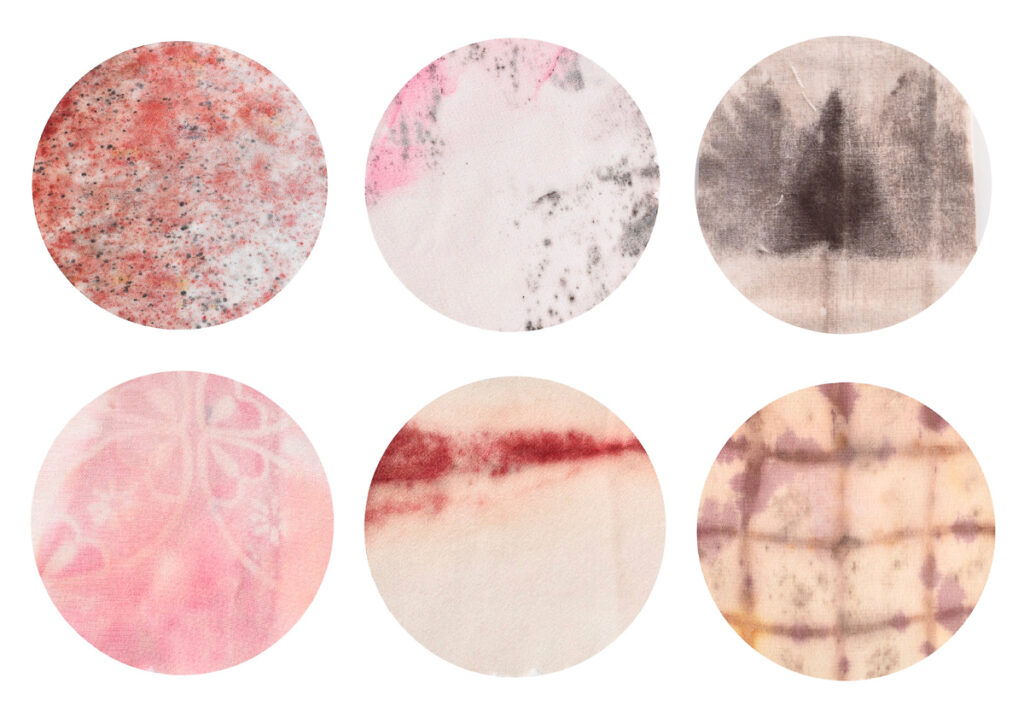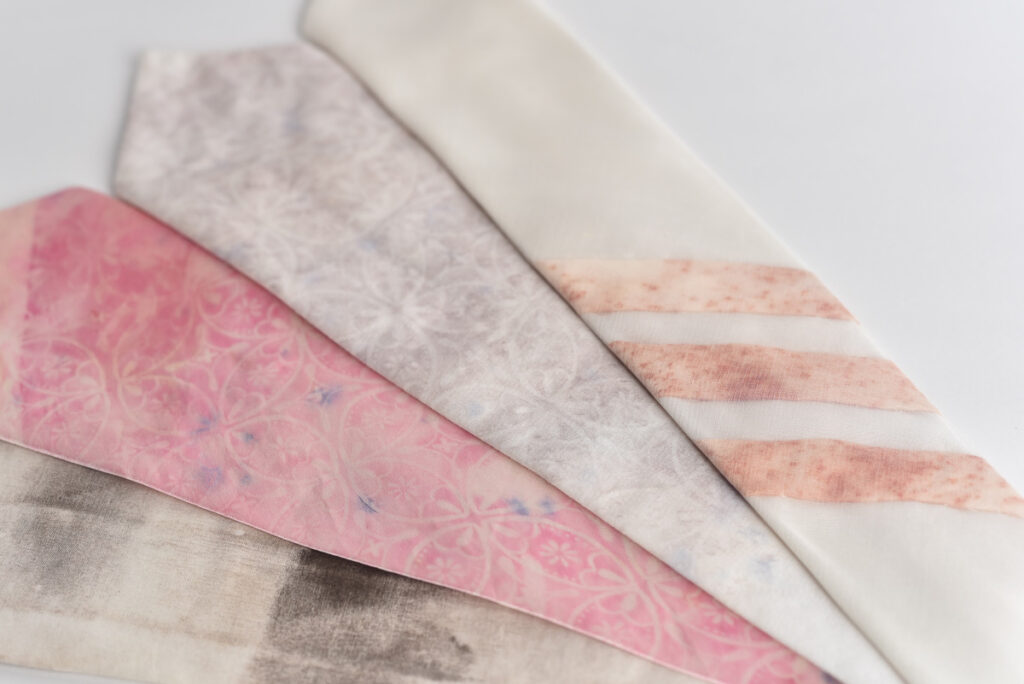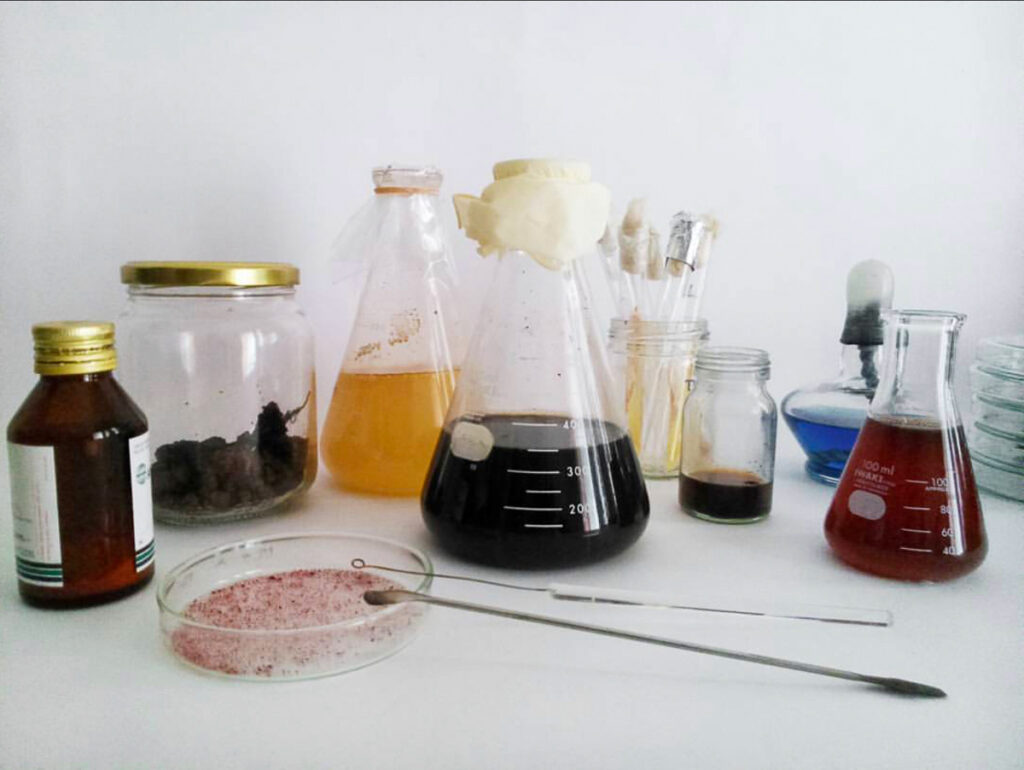
Nidiya Kusmaya, Experimental batik pattern using microorganisms, 2019, silk, 3in x 63in
Nidiya Kusmaya reveals the benefits of micro-farming in ecological batik production.
I am inspired by the stains caused by microfungus on textiles in a humid environment. I believe there is value in recognising the plethora of living things. I see the reflection of that value in the form of invisible living organisms, such as microfungus and bacteria. In my research for the past few years, I have explored the potential of microorganisms as a source of pigment, especially in textile. Textile material with the natural process is the means of realising my artistic endeavour and to fulfil human basic needs of clothing.
Indonesian craft products, especially batik, have a long history of acculturation. Batik materials such as cotton fabric, wax and vegetable dyes are readily available in Indonesia. But due to its demand for quantities and uniformity of colour, the use of natural dyes began to be replaced with synthetic alternatives.
Previously we worked towards industrially produced materials and products, everything has to be replicable perfectly. Textile craft products including batik were replicated in large quantities industrially by using synthetic dyes without proper waste treatment. These textile handicraft products to lose their value especially when it’s damaging the environment. But along with the green movement, the demand for organic materials based products is starting to increase. The selection of colours is widening and non-industrial green products are now in demand.

Nidiya Kusmaya, Experimental batik pattern using microorganisms,2019,silk,3in x 63in
Micro-farming involves the use of microorganisms to create natural colour. It is small scale and high yield. This particular micro-farming uses a microbial culture. It multiplies microbial organisms in growth a solid, liquid, or semi-solid growth medium in a controlled environment. It could be done at a lab inside Erlenmeyer flasks, Petri dishes, or bioreactor. The active microorganisms will grow and start producing the colors within four to twelve days. Growing microorganisms is considered to be more efficient in growth time, space and water needs, compared to conventional plantations.

Nidiya Kusmaya’s micro-farming ingredients
Conventional farming techniques cost far more in taking care of the plant’s cultivation, including space, water and fertiliser needs.
Controlled patterns can also be applied with this colouring technique during its growing process or adapting batik technique. This involves working together with nature to craft textile products in the lab. Thus, the batik making tradition is constantly evolving and adapting to cultural and environmental influences. This new alternative process produces handcraft textile consciously with a focus on the entire lifecycle of materials without losing its cultural value.
The use of batik is a strong source of identity for the Indonesian people. It crosses religious, racial and cultural boundaries. With this project, I hope batik can be part of a new dialogue between tradition and technology.
Author
 Nidiya Kusmaya is a textile artist and researcher from Sukabumi-West Java, she works in a variety of textile materials and natural dyeing methods that could be applied to various art installations and products. Currently, she is doing research in combining kitchen and agricultural waste with other uncommon material such as micro fungus and bacteria as colourant for textiles that are environmentally friendly. Through her research, she is aiming to extend the food chain into clothing material. She travels a lot to some rural areas and Islands in Indonesia to educate and teach the craft people to explore new possibilities of natural dyeing for textile. See www.nidiyakusmaya.com and @nidiyakusmaya
Nidiya Kusmaya is a textile artist and researcher from Sukabumi-West Java, she works in a variety of textile materials and natural dyeing methods that could be applied to various art installations and products. Currently, she is doing research in combining kitchen and agricultural waste with other uncommon material such as micro fungus and bacteria as colourant for textiles that are environmentally friendly. Through her research, she is aiming to extend the food chain into clothing material. She travels a lot to some rural areas and Islands in Indonesia to educate and teach the craft people to explore new possibilities of natural dyeing for textile. See www.nidiyakusmaya.com and @nidiyakusmaya

